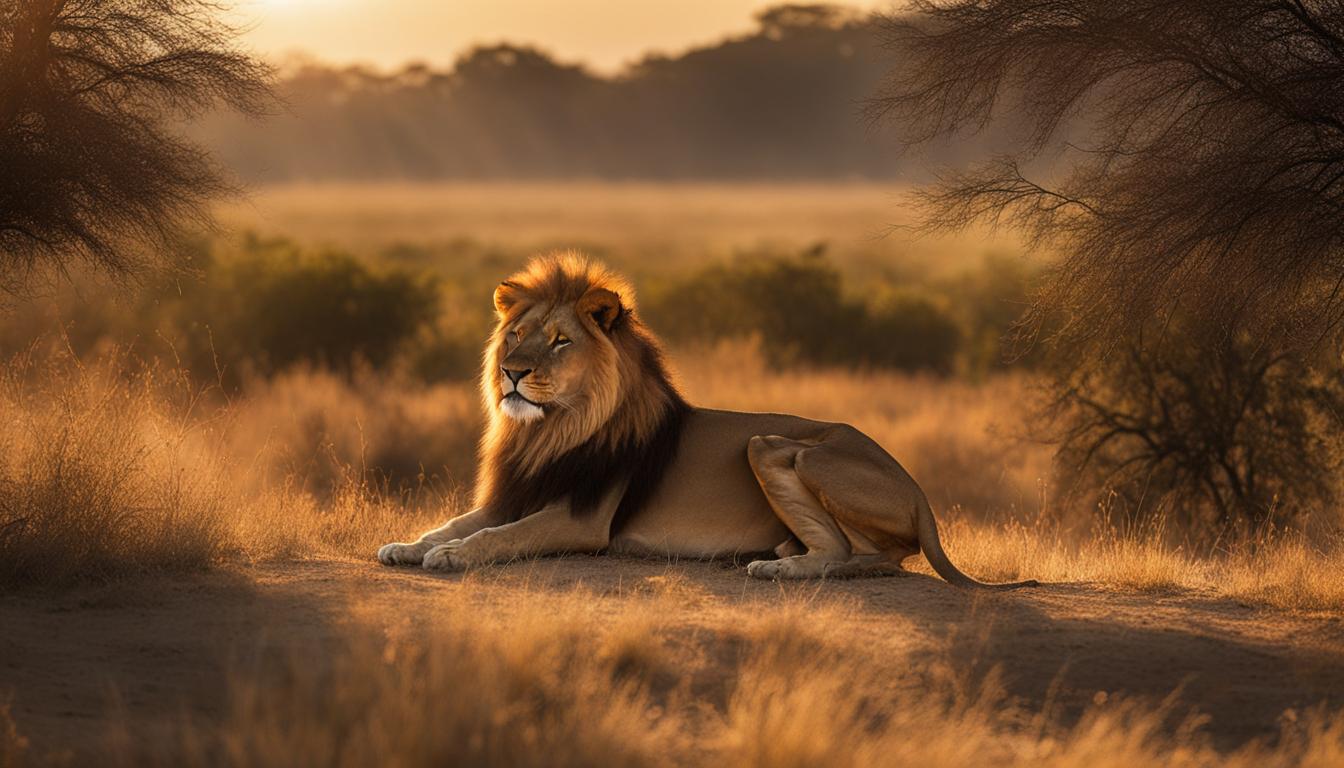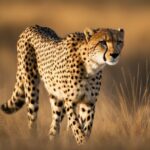Lions are fascinating creatures that have evolved over time to survive and thrive in the challenging African environments they call home. Their adaptations, whether physical, behavioral, or ecological, have contributed to their ability to not only survive but also dominate their habitats. Let’s explore some of the remarkable traits that make lions so well-suited to their African surroundings.
Key Takeaways:
- Lions have developed various adaptations to survive in their African environments.
- These adaptations include physical, behavioral, and ecological traits.
- Lions’ tan coloration provides camouflage in their surroundings.
- They possess powerful muscles and running ability for successful hunting.
- Lions live in social groups called prides, which contribute to their survival.
Physical Adaptations of Lions
Lions possess a range of physical adaptations that enable them to thrive in their African environments. Their tan coloration serves as effective camouflage, allowing them to blend seamlessly with their surroundings while stalking their prey. The distinctive mane of male lions serves both as a display of dominance and as protection during fights, shielding their vulnerable throat area. Additionally, lions have retractable claws and soft foot pads, which enable them to move silently and swiftly while hunting.
The sensory adaptations of lions play a crucial role in their survival. Lions have highly developed eyesight, particularly at night, which allows them to locate prey and navigate their surroundings in low-light conditions. Their acute sense of smell helps them detect the scent of potential prey and identify territorial markings left by other lions in their habitat.
To summarize, the physical adaptations of lions, such as their tan coloration, impressive manes, retractable claws, and keen senses, contribute to their success as skilled predators in the African wilderness.
Sensory Adaptations of Lions
A key aspect of lion adaptations is their sensory abilities. Lions possess exceptional eyesight, especially adapted for hunting in low-light conditions. This allows them to spot prey from a distance and accurately judge their movements. Additionally, their hearing is finely tuned, enabling them to detect the faintest sounds made by potential prey or rival lions. These sensory adaptations help lions to survive and thrive in their African environments.
| Sensory Adaptations | Description |
|---|---|
| Eyesight | Lions have excellent vision, particularly adapted for hunting in low-light conditions. Their eyes contain a higher number of rod cells, which are specialized for detecting movement and allow them to see clearly at night. |
| Hearing | Lions have sensitive ears that can detect a wide range of frequencies. This helps them locate prey, communicate within their pride, and stay alert to potential threats. |
| Smell | Lions have a highly developed sense of smell, allowing them to detect scents from long distances. This helps them locate prey, identify other lions in their territory, and navigate their environment. |
Behavioral Adaptations of Lions
Lions, with their majestic appearance and powerful physique, have developed a range of behavioral adaptations that contribute to their survival in the African wilderness. From their hunting techniques to their social behavior and communication, these adaptations showcase the remarkable intelligence and complexity of these apex predators.
Hunting Techniques
Lions are skilled hunters, relying on their strength, speed, and stealth to secure their prey. Females, known as lionesses, are primarily responsible for hunting in a pride. They work together, utilizing their superior teamwork and coordinated strategies to increase their chances of success. By employing stalking and ambush tactics, they approach their prey quietly and launch a calculated attack to secure a meal. This cooperative hunting ensures the survival of the pride and the successful procurement of food.
Social Behavior
Lions are highly social animals, living in prides that consist of multiple related females, their offspring, and a few unrelated adult males. This social structure strengthens their chances of survival. The cooperative nature of prides allows for better protection against threats, such as rival prides or potential predators. The lionesses within a pride share in the responsibilities of hunting, rearing cubs, and defending their territory, creating a cohesive unit that maximizes their chances of survival.
“The success and survival of a pride depend on the collective efforts and cooperation of its members.”
Communication
Lions have a diverse range of vocalizations that play a crucial role in their communication. Roaring is one of the most iconic vocalizations of lions, serving as a means of territorial declaration and communication within the pride. Lions also use grunting and woofing sounds to convey various messages to each other, maintaining social bonds and coordinating activities. These vocalizations help lions effectively navigate their surroundings, communicate vital information, and ensure the cohesion of the pride.
In conclusion, the behavioral adaptations of lions, including their hunting techniques, social behavior, and communication, are key factors in their survival and success as apex predators in their African habitats. These adaptations enable them to secure their prey, maintain a cohesive social structure, and effectively communicate within their pride. Understanding and appreciating these remarkable adaptations is crucial for the conservation and preservation of these magnificent creatures.
Lion Ecological Adaptations: Surviving in Different Habitats
Lions have remarkable ecological adaptations that allow them to thrive in a variety of habitats across Africa. These adaptations enable them to cope with different environmental conditions, ensuring their survival in diverse ecosystems.
One important adaptation of lions is their ability to withstand hot climates. Lions have physiological mechanisms that help regulate their body temperature, allowing them to stay cool in the scorching African heat. For example, they have a high tolerance for heat and can tolerate long periods without water by obtaining moisture from the blood of their prey. This adaptation is crucial in arid regions such as the Kalahari Desert, where water sources may be scarce.
Lion Adaptations in Different Ecosystems:
In addition to their ability to cope with heat, lions have also adapted to different ecosystems within Africa. For instance, in savannas and open grasslands, lions rely on their tawny coloration to blend in with the surrounding vegetation, allowing them to remain concealed while hunting. This adaptation gives them a competitive advantage by increasing their chances of a successful ambush.
Table:
| Habitat | Lion Adaptations |
|---|---|
| Desert | – Smaller manes to reduce heat retention – Adjusted breeding and hunting behaviors |
| Savanna | – Tan coloration for camouflage – Powerful muscles for chasing and capturing prey |
| Woodlands | – Enhanced night vision for hunting – Ability to climb trees for safety |
Lions also play a vital role in their respective ecosystems as both an apex predator and a keystone species. As apex predators, lions help control prey populations, maintaining a balance in the ecosystem. Their presence regulates the distribution and behavior of herbivores, preventing overgrazing and promoting biodiversity. Moreover, as a keystone species, lions influence the structure and functioning of their habitats, making them integral to the overall health of their ecosystems.
These ecological adaptations of lions highlight their incredible ability to adapt to different environments, ensuring their survival and influencing the delicate balance of African ecosystems.
Threats to Lion Adaptations
Lions, despite their impressive adaptations, face numerous threats that put their survival at risk. One of the major challenges is the decline in lion populations. As human activities expand and encroach on lion habitats, their numbers have been steadily decreasing. This decline can be attributed to various factors, including habitat loss, human-lion conflicts, and illegal hunting.
Habitat loss is a significant threat to lion populations. The conversion of natural habitats for agricultural purposes, urbanization, and infrastructure development reduces the available space for lions to roam and hunt. With shrinking habitats, lions face a scarcity of prey and increased competition, making it harder for them to survive.
Human-lion conflicts also contribute to the decline of lion populations. As human settlements expand into lion territories, conflicts arise due to competition for resources and concerns over human safety. Retaliation killings and the loss of prey due to human activities further exacerbate the threats faced by lions.
“The expansion of human activities into lion habitats has led to increased conflicts, resulting in the loss of both human lives and lion populations,” says Dr. Jane Wilson, a wildlife conservation expert.
Illegal hunting, including trophy hunting and poaching, poses a grave danger to lion populations. Despite international regulations and conservation efforts, these illegal activities continue to persist. The demand for lion parts, such as their bones, skins, and teeth, fuels this illegal trade, further decimating lion populations in some regions.
| Threat | Impact on Lion Populations |
|---|---|
| Habitat loss | Reduces available space for lions to roam and hunt, leading to scarcity of prey and increased competition. |
| Human-lion conflicts | Competition for resources, loss of prey, and retaliatory killings jeopardize lion populations. |
| Illegal hunting | Trophy hunting and poaching contribute to the decline of lion populations, driven by demand for lion parts. |
Addressing the Threats
Efforts are underway to address the threats to lion populations and protect their adaptations. Conservation organizations and governments are working together to establish protected areas, promote sustainable land use practices, and raise awareness about the importance of lion conservation. Additionally, community-based initiatives that involve local communities in conservation efforts have shown promising results in mitigating human-lion conflicts.
“Conserving lions requires a combination of measures, including habitat preservation, sustainable development practices, and community engagement,” emphasizes Dr. Wilson.
By addressing these threats and implementing effective conservation strategies, we can strive to secure a future where lions can continue to thrive and exhibit their incredible adaptations in the African ecosystems they call home.
Conclusion
Lions, with their remarkable adaptations, have evolved to survive and thrive in the diverse African environments they call home. Their physical, behavioral, and ecological traits allow them to excel as skilled hunters and social animals. From their tan coloration for effective camouflage to their strong sense of smell and eyesight, lions have honed their physical attributes to meet the challenges of their habitats.
But the survival of these majestic creatures is at stake. Habitat loss, human-lion conflicts, and illegal hunting have caused a decline in lion populations. As African savannas face rapid changes and human activities encroach on lion territories, their ability to adapt is put to the test.
To ensure the preservation of lions and their unique adaptations, conservation efforts are of utmost importance. By understanding the intricacies of lion adaptations, we can work towards protecting these magnificent animals and the delicate ecosystems they inhabit. Together, we can secure the survival of lions and champion their conservation for future generations.
FAQ
How have lions adapted to survive in their African environments?
Lions have adapted through various physical, behavioral, and ecological traits that enable them to thrive in their habitats.
What are some physical adaptations of lions?
Lions have tan coloration for camouflage, a mane for intimidation and protection, retractable claws for silent movement, and keen senses of smell and eyesight.
What are some behavioral adaptations of lions?
Lions are skilled hunters, employing stalking and ambush techniques. Females primarily hunt, while males protect the pride and communicate through vocalizations.
How do lions adapt to different environments?
Lions have physiological mechanisms to regulate body temperature in hot climates. They also adjust their breeding and hunting behaviors in response to different habitats.
What are the threats to lion adaptations?
Lions face threats such as habitat loss, human-lion conflicts, and illegal hunting, which contribute to their population decline.
Why is conservation important for lion adaptations?
Conservation efforts are crucial to protect lions and their unique adaptations, ensuring their survival and the balance of ecosystems they inhabit.







